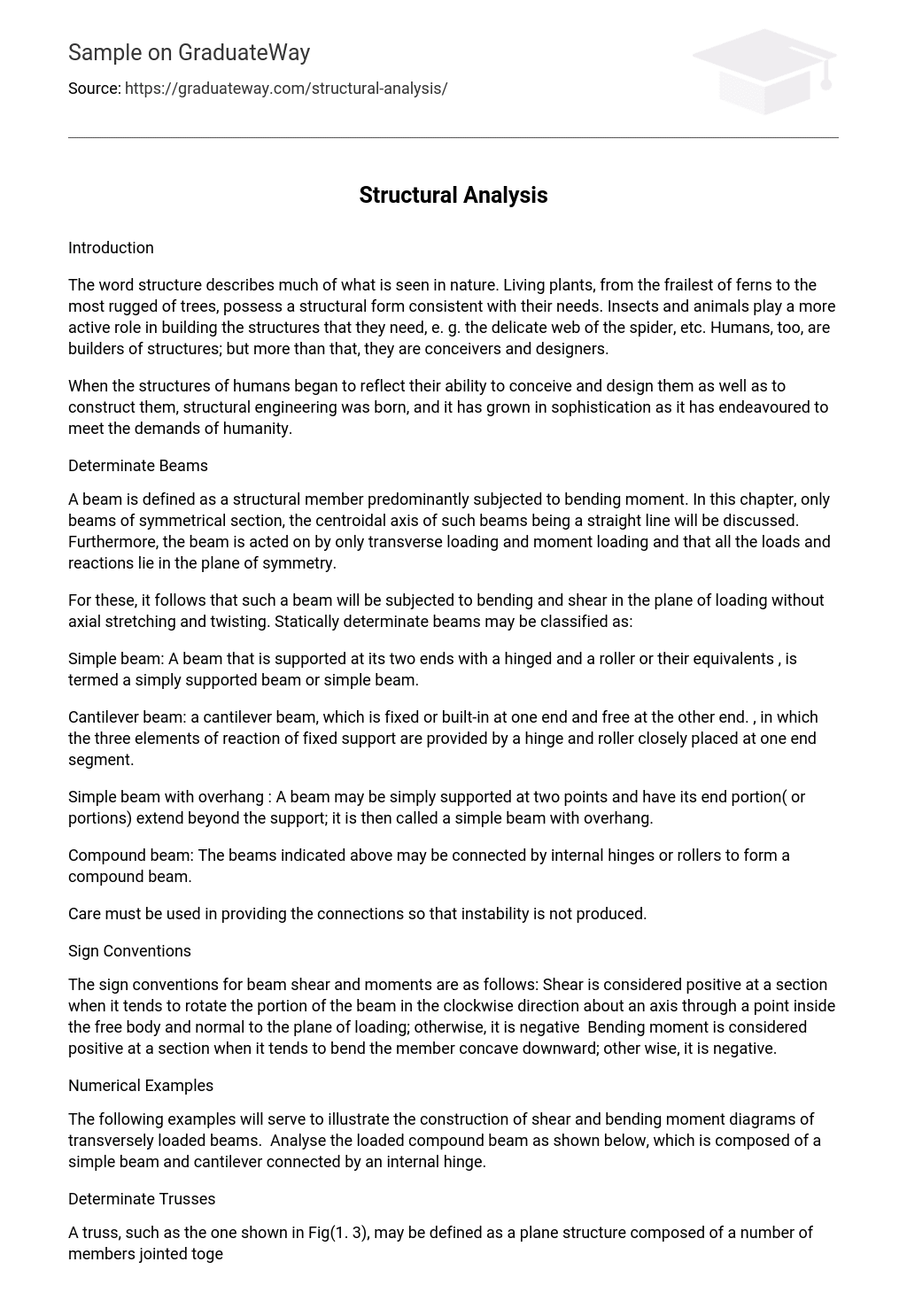Introduction
The concept of structure is evident in nature, as it determines the form of living plants such as ferns and trees. Insects and animals also construct the structures they require, like the intricate web of a spider. Likewise, humans are not only constructors but also creators and planners of structures.
Structural engineering emerged when humans started designing and constructing structures that reflected their conception and ability. Over time, the field has advanced in sophistication to meet the evolving needs of humanity.
Determinate Beams
In this chapter, we will discuss beams that are predominantly subjected to bending moment. These beams have a symmetrical section, with the centroidal axis being a straight line. Additionally, the beam is only acted upon by transverse loading and moment loading, and all the loads and reactions are located in the plane of symmetry.
In the case of these beams, it can be inferred that they will experience bending and shear within the plane of loading. There will be no axial stretching or twisting involved. Statically determinate beams can be categorized as follows:
A simply supported beam or simple beam is a beam that is supported at its two ends with a hinged and a roller or their equivalents.
A cantilever beam is a type of beam that is fixed or built-in at one end and free at the other end. It has three elements of reaction from the fixed support, which are provided by a hinge and roller closely placed at one end segment.
A simple beam with overhang refers to a beam that is supported at two points and has its end portion (or portions) extending beyond the support.
Compound beam: The above-mentioned beams can be connected through internal hinges or rollers, creating a compound beam.
Care should be taken when establishing connections to avoid causing instability.
Sign Conventions
The sign conventions for beam shear and moments are as follows: Shear is positive when it tends to rotate the portion of the beam clockwise around an axis through a point inside the free body and normal to the plane of loading. Otherwise, it is negative. Bending moment is positive when it tends to bend the member concave downward; otherwise, it is negative.
Numerical Examples
The purpose of the examples provided in this text is to demonstrate how to construct shear and bending moment diagrams for beams loaded in a transverse manner. The analysis focuses on a compound beam that consists of a simple beam and a cantilever that are connected by an internal hinge.
Determinate Trusses
A truss is a plane structure made up of several jointed members that are connected at their ends by smooth pins. This creates a rigid framework where the external forces and reactions are assumed to be in the same plane and only act at the pins. Figure 1.3 shows an example of such a truss.
Furthermore, the centroidal axis of each member of a truss aligns with the line connecting the joint centers at the ends of the member. In addition, the weight of each member is significantly smaller than other external forces acting on the truss. As a result, each member in a truss is considered a two-force member and experiences only direct axial forces (tension or compression). The complete analysis of a truss involves determining the internal axial forces in all members. It is common to represent tension with a plus sign and compression with a minus sign.
Types of Trusses
There are three classifications for common trusses based on their formations: simple, compound, and complex.
A simple plane truss can always be created by starting with three bars pinned together in the shape of a triangle and then adding two new bars for each additional joint. It is important to ensure that the new joint and the two connecting joints do not lie on the same straight line to maintain geometric stability. All of the trusses shown are simple trusses. The shaded triangle abc in each truss diagram serves as the foundation, with two additional bars being added to connect each new joint in alphabetical order.
A compound truss is formed when multiple simple trusses are connected together to create a single rigid framework. This can be achieved by joining one simple truss to another at specific joints using three non-parallel and non-concurrent links, or their equivalent.
Determinate Rigid Frames
A rigid frame is a structure made up of joints and members. These joints can be rigid or pin-connected. Rigid joints are capable of resisting both force and moment, while pin-connected joints only resist force. When analyzing rigid frames, the centroidal axis of each member is assumed to align with the line connecting the joint centers at the ends of the member. The joint center, also known as the joint centroid, is the point where all the centroidal axes of members that meet at the joint intersect. With rigid joints, the connected members not only translate but also rotate by the same amount at the joint.
Analysis of Statically Determinate Rigid Frames
Typically, rigid frames have a high level of static indeterminacy. The analysis of determinate rigid frames in this chapter is mainly of academic importance and does not have much practical application. It acts as an introduction to the analysis of indeterminate frames.
To analyze a statically determinate rigid frame, we start by finding the reaction components from statistical equations for the entire structure. Once this is done, we can determine the shear, moment, and axial force at any cross section of the frame by taking a free body cut through that section and using equilibrium equations. By plotting the shear, bending moment, and direct force diagrams based on the centroidal axis of each member, we can analyze the rigid frame. However, our main focus in the analysis of a rigid frame is the bending moment diagram.





